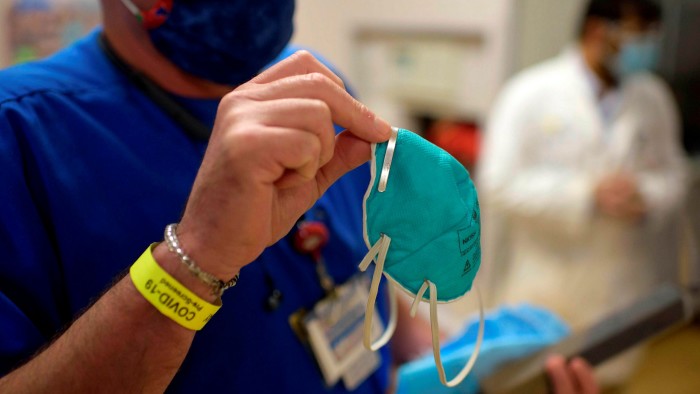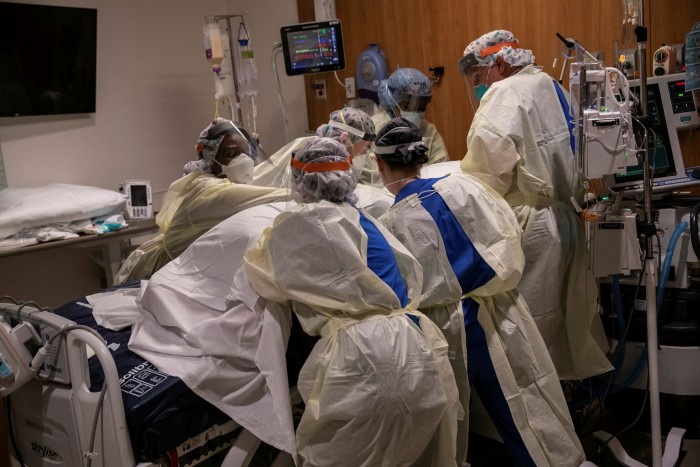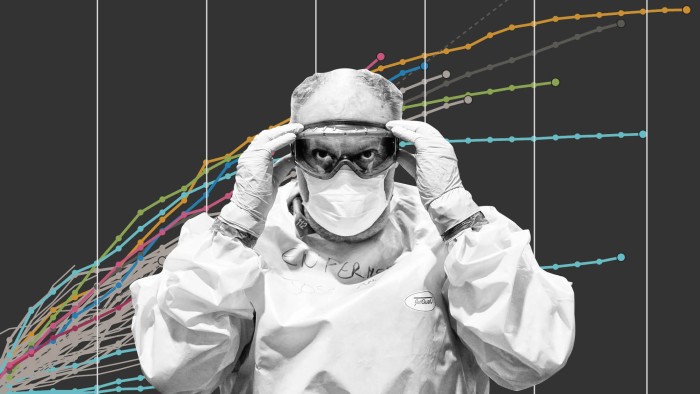Coronavirus survival: why doctors are turning patients onto their stomachs | Free to read

Roula Khalaf, Editor of the FT, selects her favourite stories in this weekly newsletter.
When a coronavirus patient exhibiting low oxygen levels is admitted to University Hospital in San Antonio, Texas, they are immediately flipped on to their stomach in bed.
The practice, known as proning, improves patients’ chances of survival, according to Dr Owais Durrani, a resident physician in the hospital’s emergency department. “It works miracles,” he said.
When Covid-19 began to spread rapidly through the US in March, patients would typically spend day after day lying on their backs in hospital beds, until doctors realised that turning them on their fronts allowed more oxygen to enter the lungs.
Proning is one of a number of ostensibly small adjustments that doctors have been making to how Covid-19 patients are cared for in hospitals. Others include waiting as long as possible before putting a patient on a ventilator and being more attuned to complications such as blood clots and fungal infections.
The use of steroids and, to a lesser extent, Gilead’s experimental drug remdesivir is also improving patients’ odds.

Doctors in sunbelt states in the US south and west, where hospitalisations are now surging, hope that the cumulative effect of these relatively minor changes will lead to lower mortality rates in their hospitals than in places where healthcare systems crumbled early in the outbreak, such as New York.
“I think it’s one of the reasons we’re seeing death rates that are not as high as the places that were hardest hit early on,” said Dr Durrani.
Even as cases have surged in states including Arizona, Texas, Florida and California, mortality rates there are still well below that of New York.
In Texas, the Covid-19 death rate per 100,000 people is 11.6, according to the US Centers for Disease Control and Prevention. This compares with 278.1 in New York City and 78.6 in the rest of the state.
The vast majority of the disparity can be attributed to the fact that deaths trail increases in case counts and hospitalisations. Some states, including Texas, also record only confirmed Covid-19 deaths, rather than probable related ones, which lowers recorded mortality rates.
However, data from hospitals in New York that were quick to change the way they looked after patients show day-to-day modifications can affect whether a patient becomes critically ill.
A study of more than 5,000 New York patients, which was published in the BMJ, found that “outcomes seem to be improving over time, potentially suggesting improvements in care”.
Dr Leora Horwitz, an associate professor of population health and medicine at NYU Langone Health and one of the authors of the study, said: “We have certainly seen a decrease in mortality within our own institution, which persists to this day even on a risk-adjusted basis.”
She added: “It makes me optimistic that even without a blockbuster treatment, all the small changes can make a difference.”
Dr Horwitz stressed the dangers of comparing unadjusted mortality figures, however, noting that many of the people testing positive for Covid-19 in sunbelt states are younger than those affected in other outbreaks.
“Just to say we have a bunch of infected 20-year-olds and the death rate is lower doesn’t mean anything,” she said. “It’s important to disentangle population health from death rates.”

Even a seemingly small change, such as proning, can be difficult to implement. While it is relatively common to put a sedated patient in intensive care on their front, it is much harder to make a conscious one lie on their stomach for up to 16 hours a day.
At NYU Langone, hospital administrators purchased extra pillows to put under patients’ hips and legs and produced a tutorial video to teach nurses how to care for people lying prone.
Healthcare workers have also used novel ways of sharing best practices at a time when many are struggling under unprecedented workloads. Some doctors have turned to Twitter and other social networks to telegraph their findings.
“Twitter has been for me and many [others] a really important source of early information,” said Dr Horwitz. “Doctors are using it to share a lot of technical information quickly.”
At the start of the pandemic, Dr Ruth Ann Crystal at Stanford Medicine in California, set up a WhatsApp group for doctors. After more than 256 signed up — breaching the messaging platform’s limit — she switched to Slack, on which she administers a group that numbers more than 1,000 practitioners.
She also created a shared Google doc, titled Coronavirus Tech Handbook for Doctors, which now runs to 48 pages, to summarise research and clinical findings.
“The sunbelt clinical areas have learnt so much from what doctors in places like New York now know about this new virus, which acts so differently from other viruses,” said Dr Crystal.
The hope is that these lessons will result in fewer deaths in states such as Texas, Arizona and Florida, even if the current mortality rates present an overly rosy picture.
Still, Dr Horwitz warns that hospitals in the sunbelt will struggle as they continue to be swamped by a surge of new coronavirus patients.
“In New York, the health system was overwhelmed and that is happening in the south now,” she said. “Some of the bad outcomes we are going to see are because they just can’t cope with the volume.”
She added: “None of this is to say [mortality] won’t be lower — I hope it will be — but it’s not going to be by a big magnitude.”
Latest coronavirus news

Follow FT's live coverage and analysis of the global pandemic and the rapidly evolving economic crisis here.
Comments